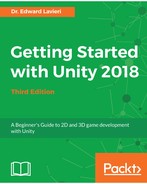Cameras render scenes so that the user can view them. Think about the hidden complexity in that statement. Our games are 3D, but people playing our games view them on 2D displays such as a televisions, computer monitors, or mobile devices. Fortunately for us, Unity makes implementing cameras easy work.
Cameras are GameObjects and can be edited using transform tools in the Scene view as well as in the Inspector panel. Every scene must have at least one camera. In fact, when a new scene is created, Unity creates a camera named Main Camera. As you will see later in this chapter, a scene can have multiple cameras.
In the Scene view, cameras are indicated with a white camera silhouette, as shown in the following screenshot:

When we click our Main Camera in the Hierarchy panel, we are provided with a Camera Preview in the Scene view. This gives us a preview of what the camera sees as if it were in game mode. We will change this in Chapter 7, Implementing Our Player Character. We also have access to several parameters via the Inspector panel. The Camera component in the Inspector panel is shown here:

Let's look at each of these parameters with relation to our Cucumber Beetle game:
- The Clear Flags parameter lets you switch between Skybox, Solid Color, Depth Only, and Don't Clear. The selection here informs Unity which parts of the screen to clear. We will leave this setting as Skybox. You will learn more about Skyboxes later in this chapter.
- The Background parameter is used to set the default background fill (color) of your game world. This will only be visible after all game objects have been rendered and if there is no Skybox. Our Cucumber Beetle game will have a Skybox, so this parameter can be left with the default color.
- The Culling Mask parameter allows you to select and deselect the layers you want the camera to render. The default selection options are Nothing, Everything, Default, TransparentFX, Ignore Raycast, Water, and UI. For our game, we will select Everything. If you are not sure which layer a game object is associated with, select it and look at the Layer parameter in the top section of the Inspector panel. There you will see the assigned layer. You can easily change the layer as well as create your own unique layers. This gives you finite rendering control.
- The Projection parameter allows you to select which projection, perspective or orthographic, you want for your camera. We will cover both of those projections later in this chapter. When perspective projection is selected, we are given access to the Field of View parameter. This is for the width of the camera's angle of view. The value range is 1-179°. You can use the slider to change the values and see the results in the Camera Preview window. When orthographic projection is selected, an additional Size parameter is available. This refers to the viewport size. For our game, we will select perspective projection with the Field of View set to 60.
- The Clipping Planes parameters include Near and Far. These settings set the closest and furthest points, relative to the camera, that rendering will happen at. For now, we will leave the default settings of 0.3 and 1000 for the Near and Far parameters, respectively.
- The Viewport Rect parameter has four components – X, Y, W, and H – that determine where the camera will be drawn on the screen. As you would expect, the X and Y components refer to horizontal and vertical positions, and the W and H components refer to width and height. You can experiment with these values and see the changes in the Camera Preview. For our game, we will leave the default settings.
- The Depth parameter is used when we implement more than one camera. We can set a value here to determine the camera's priority in relation to others. Larger values indicate a higher priority. The default setting is sufficient for our game.
- The Rendering Path parameter defines what rendering methods our camera will use. The options are Use Graphics Settings, Forward, Deferred, Legacy Vertex Lit, and Legacy Deferred (light prepass). We will use the Use Graphics Settings option for our game, which also uses the default setting.
- The Target Texture parameter is not something we will use in our game. When a render texture is set, the camera is not able to render to the screen.
- The Occlusion Culling parameter is a powerful setting. If enabled, Unity will not render objects that are occluded, or not seen by the camera. An example would be objects inside a building. If the camera can currently only see the external walls of the building, then none of the objects inside those walls can be seen. So, it makes sense to not render those. We only want to render what is absolutely necessary to help ensure our game has smooth gameplay and no lag. We will leave this as enabled for our game.
- The Allow HDR parameter is a checkbox that toggles a camera's High Dynamic Range (HDR) rendering. We will leave the default setting of enabled for our game.
- The Allow MSAA parameter is a toggle that determines whether our camera will use a Multisample Anti-Aliasing (MSAA) render target. MSAA is a computer graphics optimization technique and we want this enabled for our game.
